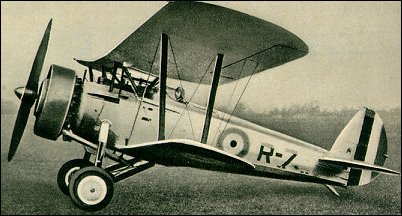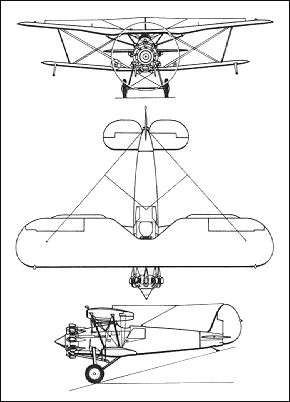 |
Bristol 105 Bulldog1927 |  |
| FIGHTER | Virtual Aircraft Museum / United Kingdom / Bristol |
 |
Between the World Wars the Bristol Aeroplane Company had very few successful designs. The outstanding one that kept the big factory busy from 1928 until 1935 was the Bulldog, the RAF's standard single-seat interceptor from the late 1920s until progressively replaced by the Fury and Gauntlet in the mid-1930s. Capt Barnwell designed the Type 105 Bulldog to meet Air Ministry Specification F.9/26. It was a sturdy unequal-span biplane with a structure chiefly of light alloy, with fabric covering. The Bristol Jupiter engine, which in the initial production Bulldog II was a 328kW Jupiter VII, was mounted in a streamlined nose with its cylinders projecting uncowled but with streamlined fairings and cooling baffles. The propeller had two wooden blades. From the first flight on 17 May 1927 handling was excellent. Features included Frise ailerons on the large upper wing and an adjustable trimming tailplane. In confor-mity with standard British practice the armament comprised two 7.62mm Vickers machine-guns with their breeches accessible to the pilot (so that he could clear stoppages with a mallet and recock the offending weapon) and firing along channels in the forward fuselage and between the cylinders of the engine. Four 9 kg bombs could be carried under the small lower wing. Standard equipment included an oxygen bottle and radio. After final evaluation against the Hawker Hawfinch the Bulldog was selected in 1928, Bristol having quickly produced a Mk II prototype with a longer fuselage and other changes to rectify previous minor faults. The first batch comprised 25 aircraft, of which 23 went to RAF fighter squadrons beginning with No 3 in 1929. Altogether 92 Bulldog II were built, one of which was retained for trials with Mercury engines in more advanced forms of cowling. Seventeen went to Latvia, eight to the RAAF, two to the US Navy, two to Siam, 12 to Estonia, three to Sweden and one to Chile. A civil demonstrator flown in June 1930 was stressed for greater gross weight and led to the main production version, the Bulldog IIA, the usual engine of which was the 365kW Jupiter VIIF with forged cylinder heads. By November 1933 Bristol had built 262 of this model, of which eight went to Sweden and 253 to the RAF. Four more, called Bristol 105D, were supplied to Denmark with Madsen guns and other changes. Two improved and much faster aircraft with the Mercury engine and Townend ring cowl were designated Bulldog IIIA, leading to the strengthened four-aileron Bulldog IVA, with a 477kW Mercury VIS2 and full-length cowl. This was beaten by the Gladiator for RAF orders, but 17 were built for Finland in the first two months of 1935. The last Bulldog was an all-stainless-steel Mk IIA for the Air Ministry. Back in 1931 a Mk IIA had been rebuilt into a dual-control advanced trainer. In December 1932 a modified trainer, called Bulldog TM (Training Machine), went into production as a standard type for the RAF. By December 1934 no fewer than 60 had been delivered. They were designed so that by fitting different rear fuselages, and adding guns (for which provision was made), they became fighters; but this was never necessary. Bulldogs remained in full RAF service until 1937, and until 1940 with Baltic air forces.
|  COMPANY PROFILE | ||||||||||||||||||||||||||||||||||||||||||||||||||||||
 |

|

